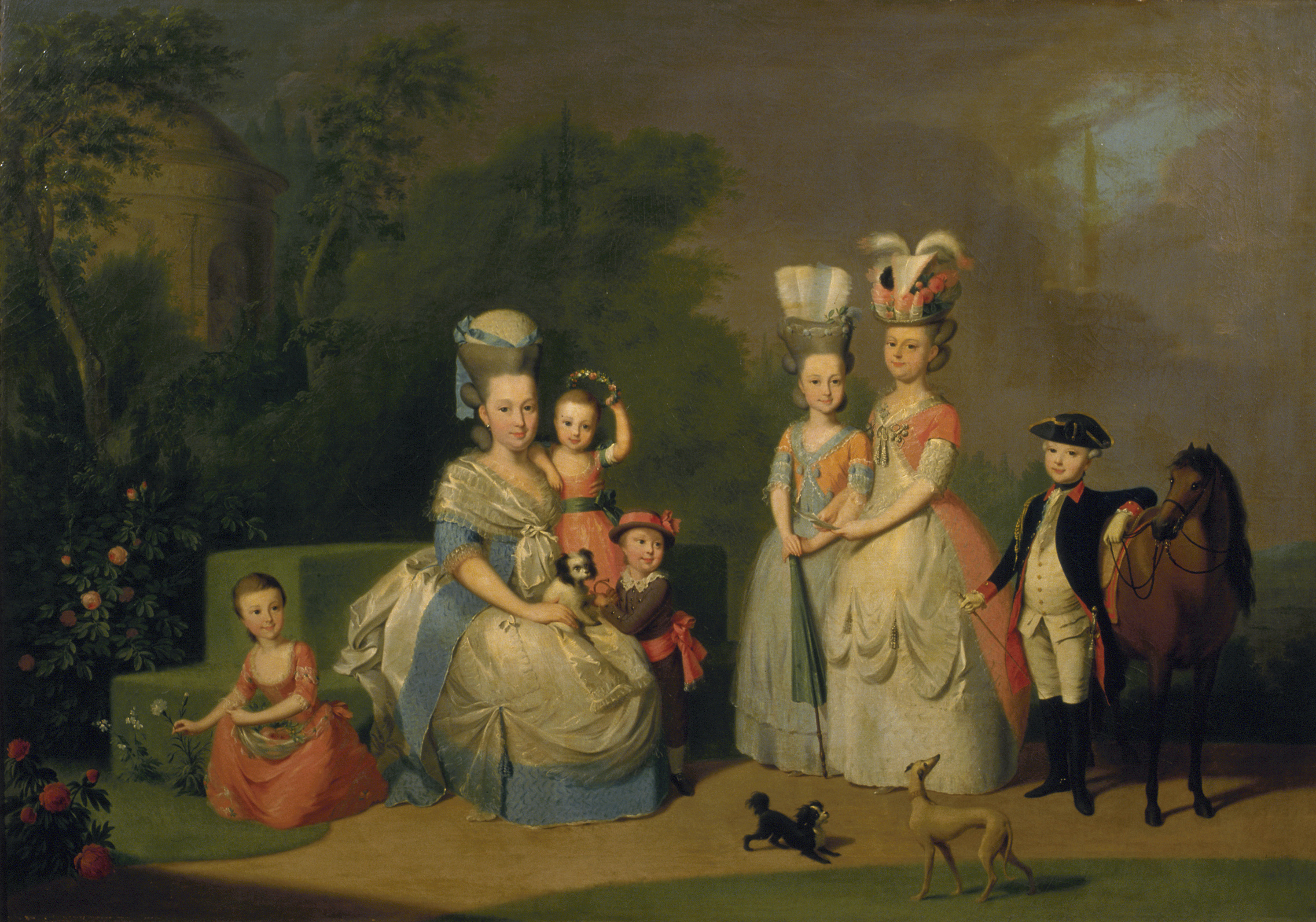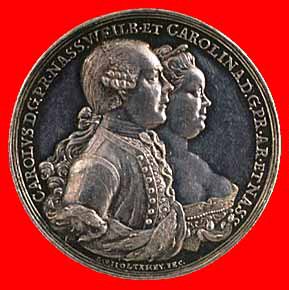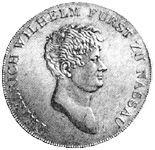|
Henrietta Of Nassau-Weilburg
Henrietta Alexandrine Friederike Wilhelmine of Nassau-Weilburg, then of Nassau (areas now part of Germany) (30 October 1797 Palace Eremitage, Bayreuth – 29 December 1829, Vienna) was the wife of Archduke Charles, Duke of Teschen. Her husband was a notable general of the Napoleonic Wars and victor of the Battle of Aspern-Essling against Napoleon I of France. Family Henrietta was the youngest daughter of Frederick William of Nassau-Weilburg (1768–1816) and his wife Burgravine Louise Isabelle of Kirchberg. Her paternal grandparents were Karl Christian of Nassau-Weilburg and Princess Wilhelmine Carolina of Orange-Nassau. Wilhelmine Carolina was a daughter of William IV, Prince of Orange and Anne, Princess Royal. Anne was in turn the eldest daughter of George II of Great Britain and Caroline of Ansbach. Marriage On 15 September/17 September 1815 in Weilburg, Henrietta married Archduke Charles of Austria. The bride was almost eighteen years old and the groom forty-four. Her hus ... [...More Info...] [...Related Items...] OR: [Wikipedia] [Google] [Baidu] |
Duchess Of Teschen
Duchess of Teschen House of Piast, 1290–1653 House of Habsburg, 1653–1722 House of Lorraine, 1722–1765 House of Habsburg-Lorraine, 1765–1918 See also * List of Polish consorts * List of Austrian consorts * Holy Roman Empress * List of Hungarian consorts * List of Bohemian consorts * List of Lotharingian consorts * List of Tuscan consorts The Grand Duchy of Tuscany was founded in 1569. It succeeded the Duchy of Florence. The grand duchy was initially ruled by the House of Medici, until their extinction in 1737. The grand duchy passed to the House of Lorraine, and then, to its cadet ... Notes References Sources * * * {{DEFAULTSORT:Duchess Of Teschen Teschen ... [...More Info...] [...Related Items...] OR: [Wikipedia] [Google] [Baidu] |
Calvinism
Calvinism (also called the Reformed Tradition, Reformed Protestantism, Reformed Christianity, or simply Reformed) is a major branch of Protestantism that follows the theological tradition and forms of Christian practice set down by John Calvin and other Reformation-era theologians. It emphasizes the sovereignty of God and the authority of the Bible. Calvinists broke from the Roman Catholic Church in the 16th century. Calvinists differ from Lutherans (another major branch of the Reformation) on the spiritual real presence of Christ in the Lord's Supper, theories of worship, the purpose and meaning of baptism, and the use of God's law for believers, among other points. The label ''Calvinism'' can be misleading, because the religious tradition it denotes has always been diverse, with a wide range of influences rather than a single founder; however, almost all of them drew heavily from the writings of Augustine of Hippo twelve hundred years prior to the Reformation. The na ... [...More Info...] [...Related Items...] OR: [Wikipedia] [Google] [Baidu] |
Weilburg
Weilburg is, with just under 13,000 inhabitants, the third biggest town in Limburg-Weilburg district in Hesse, Germany, after Limburg an der Lahn and Bad Camberg. Geography Location The community lies in the Lahn valley between the Westerwald and the Taunus just upstream from where the Weil empties into the river Lahn and 80 km southeast of Koblenz. The Old Town, built on and around a rocky hill, is almost encircled by the Lahn. Neighbouring communities Weilburg borders in the north on the communities of Merenberg and Löhnberg (both in Limburg-Weilburg), in the east on the town of Braunfels (Lahn-Dill-Kreis), in the south on the communities of Weilmünster and Weinbach as well as on the town of Runkel, and in the west on the community of Beselich (all in Limburg-Weilburg). Constituent communities Besides the main town, in which just under 40% of the inhabitants live, the outlying centres of Ahausen, Bermbach, Drommershausen, Gaudernbach, Hasselbach, Hirschhause ... [...More Info...] [...Related Items...] OR: [Wikipedia] [Google] [Baidu] |
Archduke Charles Of Austria (J
Archduke Charles Louis John Joseph Laurentius of Austria, Duke of Teschen (german: link=no, Erzherzog Karl Ludwig Johann Josef Lorenz von Österreich, Herzog von Teschen; 5 September 177130 April 1847) was an Austrian field-marshal, the third son of Emperor Leopold II and his wife, Maria Luisa of Spain. He was also the younger brother of Francis II, Holy Roman Emperor. Despite being epileptic, Charles achieved respect both as a commander and as a reformer of the Austrian army. He was considered one of Napoleon's more formidable opponents and one of the greatest generals of the French Revolutionary Wars. He began his career fighting the revolutionary armies of France. Early in the wars of the First Coalition, he saw victory at Neerwinden in 1793, before being defeated at Wattignies 1793 and Fleurus 1794. In 1796, as chief of all Austrian forces on the Rhine, Charles defeated Jean-Baptiste Jourdan at Amberg, Würzburg and Limburg, and then won victories at Wetzlar, Emmendingen and ... [...More Info...] [...Related Items...] OR: [Wikipedia] [Google] [Baidu] |
Caroline Of Ansbach
, father = John Frederick, Margrave of Brandenburg-Ansbach , mother = Princess Eleonore Erdmuthe of Saxe-Eisenach , birth_date = , birth_place = Ansbach, Principality of Ansbach, Holy Roman Empire , death_date = , death_place = St James's Palace, London, Great Britain , burial_date = 17 December 1737 , burial_place = Westminster Abbey, London Caroline of Brandenburg-Ansbach (Wilhelmina Charlotte Caroline; 1 March 1683 – 20 November 1737) was Queen of Great Britain and Ireland and Electress of Hanover from 11 June 1727 until her death in 1737 as the wife of King George II. Caroline's father, Margrave John Frederick of Brandenburg-Ansbach, belonged to a branch of the House of Hohenzollern and was the ruler of a small German state, the Principality of Ansbach. Caroline was orphaned at a young age and moved to the enlightened court of her guardians, King Frederick I and Queen Sophia Charlotte of Prussia. At the Prussian court, her previously limited education was widen ... [...More Info...] [...Related Items...] OR: [Wikipedia] [Google] [Baidu] |
George II Of Great Britain
, house = Hanover , religion = Protestant , father = George I of Great Britain , mother = Sophia Dorothea of Celle , birth_date = 30 October / 9 November 1683 , birth_place = Herrenhausen Palace,Cannon. or Leine Palace, Hanover , death_date = , death_place = Kensington Palace, London, England , burial_date = 11 November 1760 , burial_place = Westminster Abbey, London , signature = Firma del Rey George II.svg , signature_alt = George's signature in cursive George II (George Augustus; german: link=no, Georg August; 30 October / 9 November 1683 – 25 October 1760) was King of Great Britain and Ireland, Duke of Brunswick-Lüneburg (Hanover) and a prince-elector of the Holy Roman Empire from 11 June 1727 ( O.S.) until his death in 1760. Born and brought up in northern Germany, George is the most recent British monarch born outside Great Britain. The Act of Settlement 1701 and the Acts of Union 1707 positioned his grandmother, ... [...More Info...] [...Related Items...] OR: [Wikipedia] [Google] [Baidu] |
Anne, Princess Royal And Princess Of Orange
Anne, Princess Royal and Princess of Orange (12 January 1759) was the second child and eldest daughter of King George II of Great Britain and his consort Caroline of Ansbach. She was the wife of William IV, Prince of Orange, the first hereditary stadtholder of all seven provinces of the Northern Netherlands. She was Regent of the Netherlands from 1751 until her death in 1759, exercising extensive powers on behalf of her son William V. She was known as an Anglophile, due to her English upbringing and family connections, but was unable to convince the Dutch Republic to enter the Seven Years' War on the side of the British. Princess Anne was the second daughter of a British sovereign to hold the title Princess Royal. In the Netherlands she was styled Anna van Hannover. Early life Anne was born at Herrenhausen Palace, Hanover, five years before her paternal grandfather, Elector George Louis, succeeded to the thrones of Great Britain and Ireland as George I. She was christened sho ... [...More Info...] [...Related Items...] OR: [Wikipedia] [Google] [Baidu] |
William IV, Prince Of Orange
William IV (Willem Karel Hendrik Friso; 1 September 1711 – 22 October 1751) was Prince of Orange from birth and the first hereditary stadtholder of all the United Provinces of the Netherlands from 1747 until his death in 1751. During his whole life he was furthermore ruler of the Principality of Orange-Nassau within the Holy Roman Empire. Early life William was born in Leeuwarden, Netherlands, the son of John William Friso, Prince of Orange, head of the Frisian branch of the House of Orange-Nassau, and of his wife Landgravine Marie Louise of Hesse-Kassel (or Hesse-Cassel). He was born six weeks after the death of his father. William succeeded his father as Stadtholder of Friesland and also, under the regency of his mother until 1731, as Stadtholder of Groningen. In 1722 he was elected Stadtholder of Guelders. The four other provinces of the Dutch Republic:, Holland, Zeeland, Utrecht and Overijssel had in 1702 decided not to appoint a stadtholder after the death of stadtholder ... [...More Info...] [...Related Items...] OR: [Wikipedia] [Google] [Baidu] |
Princess Wilhelmine Carolina Of Orange-Nassau
Princess Carolina of Orange-Nassau (''Wilhelmine Carolina''; 28 February 1743 – 6 May 1787) was a Dutch regent. She was the daughter of William IV, Prince of Orange, Stadtholder of the Netherlands, and Anne, Princess Royal. She was regent of the Netherlands from 1765 until 1766 during the minority of her brother, William V. Life Princess Carolina was born in Leeuwarden, the eldest daughter of William IV, Prince of Orange, Stadtholder of the Netherlands, and Anne, Princess Royal. In 1747, it was declared that the position of stadtholder could be inherited by females, thus making the young Princess Carolina the heir presumptive to the position of stadtholder. However, in 1748, a male heir, William, was born to her parents, thus displacing her and putting her second in line to the position. She was given a good education in music. Princess Carolina's father died in 1751, making her three-year-old brother William V of Orange. At that point, her mother was appointed regent. Her marria ... [...More Info...] [...Related Items...] OR: [Wikipedia] [Google] [Baidu] |
Karl Christian Of Nassau-Weilburg
Charles Christian, Prince of Nassau-Weilburg (Weilburg, 16 January 1735 – Münster-Dreissen, near Kirchheim, 28 November 1788), till 1753 Count of Nassau-Weilburg, was the first ruler of the Principality of Nassau-Weilburg between 1753 and 1788. Family and rule He was the son of Charles August, Prince of Nassau-Weilburg and Princess Auguste Friederike of Nassau-Idstein. He succeeded his father in 1753 and united his territories in 1783 with Nassau-Saarbrücken, Nassau-Usingen and Nassau-Dietz. Marriage He married on 5 March 1760 in The Hague Princess Carolina of Orange-Nassau (1743–1787), daughter of William IV, Prince of Orange and Anne, Princess Royal. He became a general in the Dutch infantry, governor of Bergen op Zoom and governor of Maastricht (1773–1784). He negotiated in vain with the Patriots in 1787. After the death of his wife, he concluded a morganatic marriage with Barbara Giessen von Kirchheim. He died in 1788 and was succeeded by his eldest surviving son ... [...More Info...] [...Related Items...] OR: [Wikipedia] [Google] [Baidu] |
Frederick William Of Nassau-Weilburg
Frederick William, Prince of Nassau-Weilburg (25 October 1768, The Hague – 9 January 1816, Weilburg) was a ruler of Nassau-Weilburg. He was created Prince of Nassau and reigned jointly with his cousin, Prince Frederick Augustus of Nassau-Usingen, who became Duke of Nassau. Frederick William died in January 1816, only two months before his cousin. Both men were succeeded by Frederick William's son, William. Family Frederick William was the eldest surviving son of Karl Christian of Nassau-Weilburg and Princess Wilhelmine Carolina of Orange-Nassau. Wilhelmine Carolina was a daughter of William IV, Prince of Orange and Anne, Princess Royal and Princess of Orange. Anne was in turn the eldest daughter of George II of Great Britain and Caroline of Ansbach. Marriage and children On 31 July 1788 in Hachenburg, Frederick William married Burgravine Louise Isabelle of Kirchberg (Hachenburg, 19 April 1772 – Vienna, 6 January 1827). The groom was almost twenty years old and the bride on ... [...More Info...] [...Related Items...] OR: [Wikipedia] [Google] [Baidu] |
Napoleon I Of France
Napoleon Bonaparte ; it, Napoleone Bonaparte, ; co, Napulione Buonaparte. (born Napoleone Buonaparte; 15 August 1769 – 5 May 1821), later known by his regnal name Napoleon I, was a French military commander and political leader who rose to prominence during the French Revolution and led successful campaigns during the Revolutionary Wars. He was the ''de facto'' leader of the French Republic as First Consul from 1799 to 1804, then Emperor of the French from 1804 until 1814 and again in 1815. Napoleon's political and cultural legacy endures to this day, as a highly celebrated and controversial leader. He initiated many liberal reforms that have persisted in society, and is considered one of the greatest military commanders in history. His wars and campaigns are studied by militaries all over the world. Between three and six million civilians and soldiers perished in what became known as the Napoleonic Wars. Napoleon was born on the island of Corsica, not long afte ... [...More Info...] [...Related Items...] OR: [Wikipedia] [Google] [Baidu] |
.jpg)



_und_ihre_Kinder_Georg_August_und_Sophie_Dorothea.jpg)





